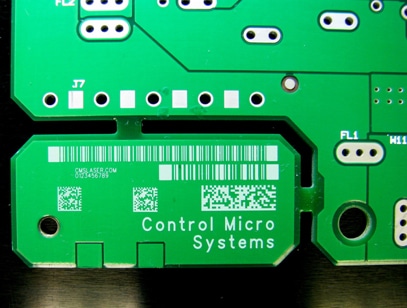 In the contemporary scene, a wide range of laser systems and sources are being put into use for direct part marking of most metallic / non-metallic electronic parts. Marking of electronics by laser induced techniques is being put into use in various industries such as glass, electronics, aerospace, appliance, automotive, medical, military, and so forth!
In the contemporary scene, a wide range of laser systems and sources are being put into use for direct part marking of most metallic / non-metallic electronic parts. Marking of electronics by laser induced techniques is being put into use in various industries such as glass, electronics, aerospace, appliance, automotive, medical, military, and so forth!
Laser marking on electronics is high-speed, permanent, and non- contact. With no stencils or masks required for the purpose, the process leaves nil thermal / mechanic stress on the parts that are marked. Today, galvanometric imaging systems, industrial lasers, and computer controls are being put into use with custom-designed laser marking tools for combining permanence, speed, and marking flexibility. Overall, laser marking techniques for electronics is versatile, precise, and cost-effective.
Marking in the Electronics Industry
The primary function of marking is to identify and recognize a product. This function is particularly important in the electronics industry because of the need to identify and use the correct components at all times. Many a times, the only method of identifying a particular component is by the marking imprinted on it. This calls for a marking method that is not easily erased but can also withstand the rough environs that are usually prevalent in the factories and the areas where the component is put to use.
In the latter half of the twentieth century, barcodes have paved the way for a new kind of marking for labeling components. Inherently hardy, these barcodes have introduced effective labeling and marking trends with respect to all industrial / non-industrial electronic components, globally.
Introduction of Lasers in Marking Electronics
The bar code was revolutionary in the sense that it could not be tampered with, and could withstand the normal rigors that the electronic industry goes through. The labeling would only take up a miniscule area of the component surface. A barcode reader, a small handy device, could read the code at a fair distance from the code. More than anything, it was the shear convenience that saw the adoption of this technology. The important feature that scored over the rest of the field was the non fading nature of the barcode with time. No other labeling system could give this feature at an affordable cost. Unlike other forms of marking, the laser marking did not cause any electrical or magnetic interference with the surrounding material.
The Economics of Lasers
Using lasers for marking electronics can be very economical and cost-effective in the long run. It is possible to work longer times with laser machines as they are inherently hardy and fault resistant. Being practically tamper proof, the markings made by laser cannot be reproduced easily. Overall, this versatile technology makes for easy application in all spheres, as also the electronics industry. Since most parts of a laser machine work with light, there are not many mechanical parts to fail or go work, causing this technology to be very reliable in nature.
So, why should all Electronics be Marked with Laser?
Laser marking of electronics offers high-speed and non-contact solutions for meeting a business’s exact requirements and for optimizing the actual applications. Combining permanence, speed, and marking flexibility that’s unparalleled by all other marking techniques, lasers are highly reliable, cost-effective, precise and versatile. Go for them.
MORE TO READ
- Technology Shifts to Laser for Metal Marking on Metal!
- Laser Technology Leads to an Incarnation of Footwear and Leather Goods
- Laser Engraved Pens – A Better Option for Customization
- Laser Technology Can Do a lot for Gift Industry
- How to Brand Your Company Through Laser
